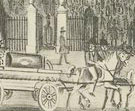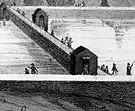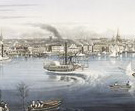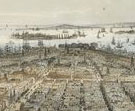|
Humanities and Social Sciences Library > Collections & Reading Rooms > Print Collection > MOVING UPTOWN Section III (including Croton Aqueduct)Water A shortage of clean drinking water had been a chronic problem in New York, and the dearth of pure water spread sickness, particularly recurring epidemics of yellow fever and cholera. By the 19th century, one source, Collect Pond (in the Foley Square area), had been filled in, and local wells were frequently polluted; rain water collected in cisterns was intended primarily for bathing and washing, not drinking. This left only the sometimes unsafe, hard, brackish water from public pumps (such as that shown in Baroness Hyde de Neuville's watercolor of Greenwich Street and Dey, the Manhattan Company reservoirs on Chambers and Centre streets, the Bowery Reservoir (seen here), the Tea Water Pump (east of Chinatown), and imported water in casks (seen in Klinckowström's view of City Hall. In 1835, the voters approved a referendum proposed by the Common Council
to dam the Croton River and to build a 45-mile-long masonry conduit to
bring water to the city. The importance of a ready supply of water was
made painfully clear by the destruction left in the wake of the Great Fire
of that year. At a cost of $11.5 million, the Croton Aqueduct, one of the
greatest American engineering projects of the 19th century, was completed
on July 4, 1842, when water was officially introduced from the 86th Street
receiving reservoir into the distributing reservoir at Fifth Avenue and
42nd Street. Hatch & Smillie (George W. Hatch and James Smillie; American engraving
firm, active 1831) 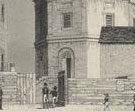 Anonymous
Nathaniel Currier (American lithographic firm, 1835–57)
after Robert Havell, Jr. and James Fulton Pringle (American, b. England,
1788–1847)
Although initially the East River commanded the lion's share of the
shipping business, the Hudson River waterfront gradually served more and
more of this traffic. Ferries from New Jersey transported passengers and
freight from points south and west, often via the rail yards in Jersey
City, at a time when railroads were carrying a growing percentage of freight.
Steam-powered vessels, which docked on the Hudson, rather than the East
River, were also taking an increasing share of passengers and freight between
American ports and between New York and Europe. Henry A. Papprill (British, active in America, 1846–about 1850) On a weekday in the 1850s, some 15,000 vehicles on average passed St. Paul's Chapel at the corner of Broadway and Fulton Street. In this view from atop St. Paul's, the steeples of St. George's, the North Dutch Church, the Post Office (formerly the Old Middle Dutch Church), and Trinity, along with the dome of the Merchants' Exchange, still rise above the densely packed three-, four-, and five-story commercial buildings, among them Brady's Daguerrian Miniature Gallery (right of center, foreground), one of some 70 establishments taking "likenesses" in New York in 1850. Barnum's American Museum straddles the corner of Broadway and Ann Street. Nearby, to the right, is Genin's hat shop. Genin had the distinction of paying $225 for a ticket to Jenny Lind's opening concert. After a catastrophic fire in 1845, which devastated the southern tip
of the island, almost all the wealthy families left Bowling Green and lower
Broadway. The few residences which survived the fire were taken over as
offices by merchants, auctioneers, and brokers; some of the buildings that
were destroyed also gave way to dry goods warehouses. Downtown was the
domain of commerce. Banks and countinghouses stretched from Bowling Green
to City Hall Park. Sarony and Major (American lithographic firm, 1846–57)
The Bourne 1830 view of the Junction of Broadway & the Bowery showed the future site of Union Square as an intersection of dirt roads in a hilly landscape, dotted with a few farms. Soon after, in 1838, the Mirror reported that "around Union Place new blocks of houses, capacious and stately, are springing up with surprising celerity. . . . Fourteenth Street will doubtless be considered at the heart rather than the extremity of the town in the course of a few years." Though in the late 1830s these buildings stood virtually alone in fields, a half mile from the edge of the city, the prediction proved accurate, for in 1845 the Herald,noted that "whole streets of magnificent dwelling houses have been erected in the vicinity of Union Square within the last year." For those status-conscious New Yorkers who moved north to this latest retreat from the noise and dust of lower Manhattan, it was reassuring that in this new neighborhood, "not a store is to be seen," "nothing but the dwellings of the aristocracy" (Herald, 1852). The bird's-eye view also suggests why Fifth Avenue a few years hence would become the stylish place to live as the city continued to grow north. Beginning at the middle of the tree-lined oasis of Washington Square (the large area of greenery in the middle right), this street ran up nearly the center of the island, passing just a short distance from fashionable Union Square. Fifth Avenue was also fortunate to have a few very wealthy New Yorkers settle there as early as the 1830s, and they, in turn, influenced other socially prominent citizens (or those with aspirations to society) to build homes there as well. In the foreground on the left, horse-drawn cars of the New York & Harlem
Railroad, established in 1832, carry passengers from Prince Street to Harlem
along Fourth Avenue. Nathaniel Currier (American lithographic firm, 1835–57) As the population moved north, many parishes relocated; churches were
often astute judges of real estate trends, and if located on a major thoroughfare,
often realized top dollar for their downtown property. The Old Middle Dutch
Church on Nassau Street, leased to the government in 1844, was remodeled
to serve as the Post Office; in about 1849, about 40,000 letters and 120,000
newspapers passed through this office daily. Other downtown churches, sold
by their parishes, were refitted as banks; one became offices for the commissioners
of immigration; and some even became tenements. Nathaniel Currier (American lithographic firm, 1835–57) The Merchants' Exchange, designed by Isaiah Rogers, was erected in 1836–42 on the site of an earlier Merchants' Exchange destroyed by the Great Fire. Many commented on the building frenzy that consumed New York at this time. The Mirror observed in 1840, "No sooner is a fine building erected than it is torn down to put up a better. . . . We have our misgivings as to the permanency of the Merchants' Exchange now going up on Wall Street. It is very much to be feared that it will be torn down and 'improved' before it can be fairly finished; so restless are the tastes and habitudes of the city." Philip Hone summed up this activity when he wrote in 1839, "the spirit of pulling down and building up is abroad. . . . Brickbats, rafters, and slates are showering down in every direction." The Merchants' Exchange did fare somewhat better than the Mirror predicted.
The building was later used as the United States Custom House, and in 1907
was sold to the National City Bank, which added on top another colonnaded
structure, designed by McKim, Mead and White. Nathaniel Currier (American lithographic firm, 1835–57) Looking south from City Hall Park, we see the Astor House on the right, and the American (formerly Scudder's) Museum at the corner of Broadway and Ann streets. The portico of St. Paul's is visible beyond the Astor House; in the distance is the steeple of Trinity Church. During the late 1840s and into the 1850s, Broadway up to and past Houston Street was transformed from an elegant residential boulevard to a fashionable commercial street. As Philip Hone observed in 1850, "The mania for converting Broadway into a street of shops is greater than ever." In addition to relying upon horsecars and omnibuses to get around the bustling town, New Yorkers could now hail a taxi. Taxicabs were first introduced in 1840 when Brigham Eaton put three in front of Astor House; the idea caught on quickly, and within a month another 25 were in service. |
